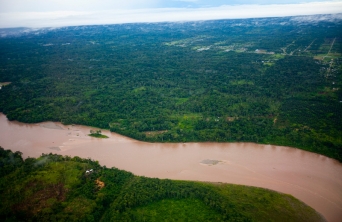Ecuador Vs. Chevron-Texaco: A Brief History
After years of searching for oil in the Ecuadorian Amazon, Gulf Oil Corp. and Texaco Petroleum Company began major shipments of oil from the region in 1972, when the Trans-Ecuadorian pipeline was completed.
Production of oil increased rapidly, on par with the country's top grossing export -- bananas. As the second largest producer of oil in South America, Ecuador soon became a member of Organization of the Petroleum Exporting Countries.
Other companies searched for oil, but none would have success like Texaco and Gulf Oil. This caused some to doubt the future of the country's oil production. One oil man told the AP:
"There's an awful lot of oil in that jungle, but this doesn't look like it will be quite the bonanza everyone expected a year or so ago."
Production by Texaco and Gulf Oil remained steady, however soon the politics of oil would rob the country of economic benefits. The Arab Oil Embargo of 1973 resulted in steep increases in petroleum prices worldwide and Ecuador was not exempt from its repercussions -- inflation took hold of Ecuador's economy by 1974. Food prices soared, and the country's military regime implemented a policy of "caution and conservatism" regarding oil production.
Two years later, inflation ebbed downward, but reports claimed that the profits associated with the country's oil industry were not seen by most of its citizens. The Ecuadorian people called for a nationalization of the oil consortium -- between Texaco, Gulf Oil, and Ecuador's government -- that controlled production.
At this point, the population was governed by a military junta. However, in 1976, Governmental Minister Richelieu Levoyer created a plan to return the country to democracy over the course of three years, giving hope of a people's government.
Gulf Oil asked to be let out of their contract due to uncertainty surrounding reasonable returns. In 1977, Ecuador's national oil company, Corporacion Estatal Petrolera Ecuatoriana (CEPE), paid Gulf Oil Co. $120 million for its 37.5 percent share of the contract -- meaning most oil operations in Ecuador were conducted by a partnership between Texaco and the Ecuadorian government.
Meanwhile, democracy was finally instituted in 1979. Jaime Roldos Aguilera won the people's vote later that year, becoming the first publicly elected official since 1972.
In response to the low demand for oil in the early '80s, Ecuador took the lead in dropping its minimum price per barrel, to the dismay of other OPEC members. Even so, the future of continuing its oil boom looked shaky at best: oil production was not at a level that could support economic growth and international demand continued to fall.
In 1989, restructuring of the national oil company led to a new name: Petroecuador.
In November of 1993, a group of indigenous Ecuadoran leaders filed a $1.5 billion suit against Texaco, accusing the oil company of massive pollution that destroyed natural environments and increased cancer rates.
Texaco officially left Ecuador in 1992, and the government absolved it of any further responsibility. Although criticized for leaving cleanup unfinished, Texaco officials maintained that fault rested with the Ecuadorian government because it lacked a comprehensive set of environmental laws while the company operated. However, the government's deal did not include third-party claims, meaning the people of the land still had their legal right to sue.
In 1994, a cancer study released by the Centre for Economic and Social Rights in New York confirmed the rise in health problems in the region.
During the 1990s, Texaco spent $40 million total in cleanup work while issuing multiple appeals to have the case tried in Ecuador rather than New York. The case remained in limbo.
Chevron acquired Texaco in 2001, and Chevron inherited the case. It continued the fight for an Ecuadorian court and, in 2002, the request was granted -- with the caveat that any judgement would be enforceable in the United States.
When the most current lawsuit was filed in 2003, the oil company again maintained that it is not legally responsible for further cleanup costs. However, the plaintiffs say the oil company was released of its partnership with Petroecuador, not from its responsibility to the people of the land. Jose Aguilar, a local settler, told the AP:
"It is irreparable damage. Everything has been damaged. People have died. Everything has been lost."
In 2008, an environmental expert recommended that Chevron should pay $27 billion to adequately cover the full extent of its damage. The figure was hotly contested by the oil company, with their representatives saying his work "contains fabricated and erroneous evidence."
On February 14, 2011, an Ecuadorian court found Chevron to be guilty, issuing a $8 billion fine -- the largest environmental penalty awarded ever -- along with an additional $8 billion if Chevron did not promptly issue an apology. Chevron refused, claiming that "by imposing this award, the court, in effect, penalized Chevron billions of dollars for exercising its fundamental right to defend itself."
Soon afterward, Chevron filed an appeal, calling the ruling "illegitimate and unenforceable." Chevron has also filed suit against the plaintiffs for racketeering -- which targets not only lawyers, but indigenous persons named within the lawsuit.






